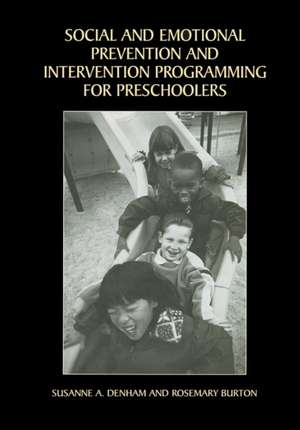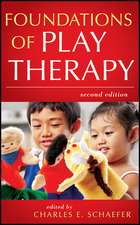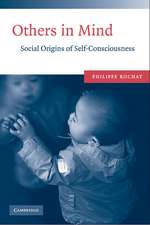Social and Emotional Prevention and Intervention Programming for Preschoolers
Autor Susanne A. Denham, Rosemary Burtonen Limba Engleză Paperback – 15 sep 2012
- Review of all extant programming for both in-class and parenting applications to further social and emotional development during early childhood
- Chapters presenting the major components of emotional competence are followed directly by another chapter detailing applications, or "lessons from the field."
| Toate formatele și edițiile | Preț | Express |
|---|---|---|
| Paperback (1) | 642.51 lei 6-8 săpt. | |
| Springer Us – 15 sep 2012 | 642.51 lei 6-8 săpt. | |
| Hardback (1) | 646.11 lei 6-8 săpt. | |
| Springer Us – 31 dec 2003 | 646.11 lei 6-8 săpt. |
Preț: 642.51 lei
Preț vechi: 755.88 lei
-15% Nou
122.94€ • 128.73$ • 101.97£
Carte tipărită la comandă
Livrare economică 09-23 aprilie
Specificații
ISBN-10: 1461349036
Pagini: 272
Ilustrații: XV, 251 p.
Dimensiuni: 178 x 254 x 17 mm
Greutate: 0.48 kg
Ediția:Softcover reprint of the original 1st ed. 2003
Editura: Springer Us
Colecția Springer
Locul publicării:New York, NY, United States
Public țintă
ResearchCuprins
1. Introduction: The Importance of Emotional and Social Competence.- 1.1. Introduction.- 1.2. Experience and Expression of Emotions.- 1.2.1. Emotional Experience.- 1.2.2. Expression of Emotions.- 1.2.2.1 Expressive Process.- 1.2.2.2. Expressive Outcomes.- 1.3. Understanding Emotions.- 1.4. Emotion Regulation.- 1.5. Emotional Competence: Developmental and Individual Differences.- 1.6. Socialization of Emotional and Social Competence.- 1.6.1. Modeling of Emotional Expressiveness.- 1.6.2. Contingent Reactions to Children’s Emotions.- 1.6.3. Teaching About Emotions.- 1.6.4. Summarizing the Socialization of Emotional Competence.- 1.7. Social Competence and Social-Emotional Learning (Sel).- 1.7.1. Linkage of Emotional and Social Competence.- 1.8. Summary and Conclusion.- 2. Targeting Programs for Preschool Emotional and Social Competence.- 2.1. Introduction.- 2.2. Sel Goals.- 2.3. How do We Reach These Sel Goals?.- 2.4. Behavior Problems and Social INCompetence.- 2.4.1. Specific Behavior Problems Associated With Lack of SEL.- 2.4.1.1. Challenging Behaviors Traced to Differing Patterns Of Risk and Resilience.- 2.4.1.2. Children Already Showing Diagnosable Problems.- 2.5. Sel Programming for Young Children.- 2.5.1. Prevention/Intervention: What Is Needed? What Has Been Done? Where Do We Go From Here?.- 2.6. Summary and Conclusion.- 3. Preschoolers’ Attachment and Emotional Competence.- 3.1. Introduction to Attachment as Foundational for Emotional Competence.- 3.2. Early Attachment Classifications and Their Sequelae.- 3.3. Attachment and Emotional Competence.- 3.4. Attachments Beyond the Child-Parent Relationship.- 3.4.1. Preschool Teachers/ Daycare Providers and Attachment.- 3.4.2. Compensatory Effects of Secure Child-Teacher Attachment.- 3.5. Principles for Practitioners.- 3.6. Summary: Attachment as Foundation for Sel.- 3.7. Conclusions: What Can We Do?.- 4. Applications Centered on Attachment: Lessons from the Field.- 4.1. Introduction to Sel Programming.- 4.1.1. Introduction to Attachment Applications.- 4.2. Attachment Theory in the Preschool Classroom.- 4.3. Teaching Teachers About Building Attachment Relationships.- 4.3.1. Initial Approaches.- 4.3.2. Roadblocks on the Way to Attachment.- 4.3.3. Moving Beyond the Roadblocks.- 4.3.4. Attachment-Specific Information Imparted.- 4.3.4.1. Elements of “Floor Time ”.- 4.3.4.2. Teaching About Floor Time.- 4.3.4.3. Curricular Elements Related to Attachment.- 4.3.4.4. Problem Areas in Creating an Attachment-Positive Classroom.- 4.4. Teaching Parents about Attachment and Floor Time.- 4.4.1. Parents and Floor Time.- 4.4.2. Intervening with Parents and Children at Risk - The Circles Of Security Program.- 4.4.2.1. Steps in the COS Program.- 4.4.2.2. Evaluation of the COS Program.- 4.4.3. The Seattle Approach.- 4.5. Summary and Conclusions.- 5. Guiding Preschoolers’Behavior: Short-Term Meanings, Long-Term Outcomes.- 5.1. Introduction: Foundations and Methods of Guidance in Early Childhood.- 5.1.1. Indirect Guidance.- 5.2. Guidance: Where Do We Start?.- 5.2.1. The Meaning of Behavior.- 5.2.2 Observing Children’s Behavior.- 5.2.3. Putting the Package Together.- 5.3. Specifics for Guiding Behavior.- 5.3.1. More Operant Approaches.- 5.3.2. Costs of “Power Assertive” Techniques.- 5.3.3. What Should We Do Instead? “Control” and “Discipline” Versus “Guidance”.- 5.3.3.1. Persistent Persuasion.- 5.3.3.2. Inductive Guidance Strategies.- 5.4. Summary and Conclusions.- 6. Teaching Teachers about Guidance: Lessons from the Field.- 6.1. Introduction: The Needs of Teachers and children.- 6.2. Training Teachers to use Indirect Guidance.- 6.3. Using Direct Guidance.- 6.4. Reflection on Guidance and Time for Practice.- 6.5. Summary and Conclusions.- 7. Emotion Understanding and Emotion Regulation.- 7.1. Emotion Understanding.- 7.1.1. Labeling Emotional Expressions.- 7.1.2. Identifying Emotion-Eliciting Situations.- 7.1.3. Comprehending Causes of Emotions.- 7.1.4. Understanding the Consequences of Emotion.- 7.1.5. Sophisticated Understanding of the Emotional Experience of Others.- 7.1.5.1. Equivocal Emotional Situations.- 7.1.5.2. Atypical Emotional Reactions: Weighing Expressive And Situational Information.- 7.1.5.3. Personalized Information.- 7.1.6. Dissemblance.- 7.1.6.1. Display Rule Knowledge.- 7.1.6.2. Knowledge of Emotion Regulation Strategies.- 7.1.6.3. Knowledge of Simultaneity of Emotions and Ambivalence.- 7.1.6.4. Knowledge of Complex Emotions.- 7.2. Emotion Knowledge and Social Interaction.- 7.2.1. Emotion Knowledge and SEL: A Key to Successful Interaction.- 7.2.2. Lack of Emotion Knowledge and Unsuccessful Social Interaction.- 7.2.3. Preschoolers’ Emotion Knowledge and More Specific SEL Deficits: The Case of Bullying.- 7.3. Emotion Regulation.- 7.3.1. Emotion Regulation: Developments During Preschool.- 7.4. Emotion Regulation and Sel.- 7.4.1. Relations with Other Aspects of Emotional Competence.- 7.5. Summary and Conclusion.- 8. Applications Centered on Emotional Competence: Lessons from the Field.- 8.1. Introduction.- 8.2. Emotion Understanding.- 8.2.1. Social-Emotional Intervention for At-Risk 4-Year-Olds.- 8.2.2. Preschool PATHS (Promoting Alternative Thinking Strategies).- 8.2.3. Second Step Preschool/Kindergarten.- 8.2.4. Head Start/ECAP Curriculum (Izard & Bear, 2001).- 8.2.5. The Incredible Years.- 8.2.6. Other Promising Programs.- 8.2.7. Summary.- 8.3. Emotional Expressiveness and Emotion Regulation.- 8.3.1. Programming in Emotional Expressiveness and Emotion Regulation: Social Emotional Intervention for At-Risk-4-Year-Olds.- 8.3.2. Programming in Emotional Expressiveness and Emotion Regulation: Second Step Preschool/Kindergarten.- 8.3.3. Programming in Emotional Expressiveness and Emotion Regulation: Head Start/ECAP Curriculum.- 8.3.4. Programming in Emotional Expressiveness and Emotion Regulation: The Incredible Years.- 8.3.5. Programming in Emotional Expressiveness and Emotion Regulation: DECI.- 8.3.6. Summary and Conclusions: Programming Possibilities.- 8.4. Notes from the Field: How We have Worked with Teachers to Implement Practices Centered on Emotional Competence.- 8.4.1. Moving Into the World of Feelings: Teachers’ First Steps.- 8.4.2. Continuing on to Emotion Knowledge: Uniting Feeling and Thinking in Karim’s Story.- 8.4.3. After Karim: What Teachers Can Do to Promote Emotion Knowledge.- 8.4.4. After Karim: What Teachers Can Do to Promote Adaptive Emotional Expressiveness and Experience.- 8.4.5. After Karim: What Teachers Can Do to Promote Emotion Regulation.- 8.4.6. Summary and Conclusion: Training Teachers About Emotional Competence Programming.- 9. Social Problem Solving.- 9.1. Introduction: Thinking about Getting along with Each Other.- 9.1.1. Social Problem Solving Expands: Social Information Processing and Emotional Competence.- 9.1.1.1. Social Problem Solving and Emotion Knowledge.- 9.1.1.2. Social Problem Solving and Emotional Expressiveness/ Emotion Regulation.- 9.2. Focus on Social Problem Solving in Preschoolers.- 9.2.1. Social Problem Solving and Social Functioning in Preschoolers: Before Social Information Processing Theory.- 9.2.2. Social Problem Solving and Social Functioning in Preschoolers: After the Advent of Social Information Processing Theory.- 9.3. Summary and Conclusions.- 10. Social Problem-Solving Applications: Lessons from the Field.- 10.1. Introduction: Teaching Social Problem Solving and Positive Social Behaviors to Preschoolers.- 10.1.1. Dialoguing as a Key to Social Problem Solving.- 10.2. Social Problem-Solving Programming.- 10.2.1. Social-Emotional Intervention for At-Risk 4-Year-Olds.- 10.2.2. Preschool PATHS (Promoting Alternative Thinking Strategies).- 10.2.3. Second Step Preschool/Kindergarten.- 10.2.4. The Incredible Years.- 10.2.5. Other Promising Programs.- 10.2.5.1. Dubas et al.- 10.2.5.2. Self-Determination Program.- 10.2.5.3.Stevahn, Johnson, Johnson, Oberle, and Wahl Conflict Resolution Program.- 10.2.5.4. Peaceful Kids Conflict Resolution Program.- 10.2.5.5.DECI.- 10.3. Teachers Learn about Social Problem Solving-Moving from Hypothetic al to Real.- 10.3.1. Models of Social Problem Solving: Our Experience.- 10.3.2. Fine-Tuning Social Problem Solving in the Classroom.- 10.3.3. Follow-up Support for Teachers New to Social Problem Solving.- 10.4. Social Competence Revisited: Relationship Skills.- 10.4.1. Social-Emotional Intervention for At-Risk 4-Year-Olds.- 10.4.2. Second Step Preschool/Kindergarten.- 10.4.3 The Incredible Years.- 10.4.4. Other Promising Programs.- 10.5. Summary and Conclusions.- 11. Improving Children’s Emotional Competence: Parenting Interventions, Written By Sophie Havighurst.- 11.1. Introduction to Parenting Sel Interventions.- 11.2. The Influence of Parenting on Children’s Emotional Competence: A Conceptual Framework.- 11.3. Universal Parenting Programs that Build Children’s Emotional Competence.- 11.3.1. Izard’s Emotion-Based Prevention Program.- 11.3.2. Gottman’s Emotion Coaching Programming.- 11.3.3. Other Approaches.- 11.4. Emotion-Focused Parenting Programs for High-Risk Children.- 11.4.1. The Incredible Years Program.- 11.4.2. Exploring Together Preschool Program.- 11.5. Self-Help Books for Parents.- 11.6. Essential Parenting: A Program to Build Children’s Emotional Competence.- 11.6.1. EPREIC and Children’s Emotional Expressiveness and Experience.- 11.6.2. EPREIC and Children’s Emotion Knowledge.- 11.6.2.1. “Emotion Detective ”.- 11.6.2.2. Feelings Faces and Feelings Stickers.- 11.6.2.3. Emotion Talk Time.- 11.6.2.4. Story Book Reading - Emotion Coaching and More.- 11.6.3. Unforeseen Initial Outcomes for EPREIC: Reasons and Solutions.- 11.7. Emotion coaching in the “Heat of the Moment”: Epreic and Chidren’s Regulation of Emotions and Emotion-Related Behavior.- 11.8. Epreic and Social Problem Solving.- 11.9. Epreic is for Parents, too: Parent Emotional Self Care and Emotional Regulation.- 11.10. Final Thoughts on the Epreic Program..180.- 11.11. Research Evaluation of Epreic.- 11.12. Future Directions.- 11.13. Summary and Conclusions.- 12. Assessing Emotional and Social Competence during Preschool Years.- 12.1. Introduction.- 12.2. Emotional Competence Assessment.- 12.2.1. Attachment to Caregivers.- 12.2.1.1. Student-Teacher Relationship Scales.- 12.2.1.2. Attachment Q-Sort (AQS).- 12.2.1.3. Narrative Story Completions: Children’s Views of Their Own Relationships.- 12.2.2. Emotional Expressiveness.- 12.2.2.1. Observed Emotional Expressiveness.- 12.2.22. Rated Emotional Expressiveness: Temperament.- 12.2.3. Emotion Knowledge.- 12.2.4. Emotion Regulation.- 12.2.4.1. Emotion Regulation as Process and Product: An Analogue Task.- 12.2.4.2. Rated Emotion Regulation as Product: Teacher Ratings.- 12.2.4.3. Rated Emotion Regulation as Process: Parent Ratings.- 12.2.4.4. Rated Emotion Regulation as Process: Strategies Reported by Parents or Teachers.- 12.3. Social Competence Assessment.- 12.3.1. Teacher Evaluations.- 12.3.1.1.Social Competence/Behavior Evaluation Short Form.- 12.3.1.2. Penn Interactive Preschool Play Scales.- 12.3.2. Peer Evaluations.- 12.4. Social Competence/Emotional Competence “Combined Assessment”.- 12.4.1. The Devereux Early Childhood Assessment (DECA).- 12.4.2. Battelle Developmental Inventory (BDI).- 12.4.3. Infant Toddler Social-Emotional Assessment (ITSEA).- 12.4.4. Minnesota Preschool Affect Checklist.- 12.4.5. “Authentic Assessment”.- 12.4.5.1. The Hawaii Early Learning Profile.- 12.4.5.2. DECI Strategies.- 12.5. Assessment of Behavioral Problems.- 12.6. Summary and Conclusions: Recommendations about Preschool Social-Emotional Assessment.- 13. What “Works”: Summarizing Our Lessons from the Field.- 13.1. Overall Considerations.- 13.2. What Works: Prevention Principles Applied to Programs Reviewed Here.- 13.2.1. Program Theoretical Basis.- 13.2.2. Comprehensive Programming.- 13.2.3. Number of Participants, Randomization of Evaluation Study.- 13.2.4. Teacher Training, Intensity of Programming, and Implementation Checks.- 13.2.5. Outcomes of Programming.- 13.3. What Works: Requirements for Early Childhood Sel Programming.- 13.3.1. Individualization of Program Techniques.- 13.3.2. Infusion.- 13.3.3. Classroom Climate, School Ecology, and Neighborhood Context.- 13.3.4. School/Family Partnerships.- 13.3.5. Cultural Competence.- 13.3.6. Reflective Training, Supervision and Consultation.- 13.4. What “Works”: How Well Do Programs Reviewed Here Fare?.- 13.5. Gaps in Science and Practice: Where We Need to know more, What “Doesn’t Work”.- 13.6. Synthesis - Dream to Reality.- References.
Notă biografică
Susanne Denham received her Ph.D. in applied developmental psychology in 1985, after 11 years as a school psychologist. Her research involves social-emotional development, particularly in preschoolers. She is following a longitudinal sample of children she has known since age 3 – examining their emotional competence, its socialization, and its contribution to social competence – and is also studying a little-studied aspect of children’s development – forgiveness. With Dr. Burton, she spearheaded a successful social-emotional prevention program for daycare children in Northern Virginia in the early 1990s.
Rosemary Burton received her Ph.D. in education in 1995, after years as both an early childhood teacher and daycare director. She trains myriad teachers in her role as director of operations for Minnieland Private Day Schools throughout several states, as well as in her role as community college professor, and in these roles has promoted social-emotional prevention and intervention programming for preschoolers as a vital enterprise.
Descriere
Social and Emotional Prevention and Intervention Programming for Preschoolers rests on the idea that young children, under optimal circumstances, develop substantial abilities in social and emotional domains by the time they enter school. These abilities contribute to their success and well-being during these early years, but even more importantly, to both their successful adaptation to school (personal and academic) and their long-term mental health.
The chapters of this volume present theoretical foundations for and explanations of what important adults in young children's lives - preschool teachers, daycare providers, parents - can do to encourage the development of such social-emotional abilities, including promoting secure attachment relationships, providing positive behavior guidance, and assisting children in developing emotion knowledge, emotion regulation, social problem-solving skills, and other positive social behaviors.
In addition, the book reviews the current state of early childhood programming in each of these crucial areas, with the addition of a chapter on emergent parent programming on emotion coaching. Recommendations are made for making such programming work, for assessing individual children's development and program efficacy, and necessary future directions for this area are detailed.
Social and Emotional Prevention and Intervention Programming for Preschoolers is a valuable resource for developmental psychologists, child psychologists, school and educational psychologists, school counselors, and early childhood educators.







